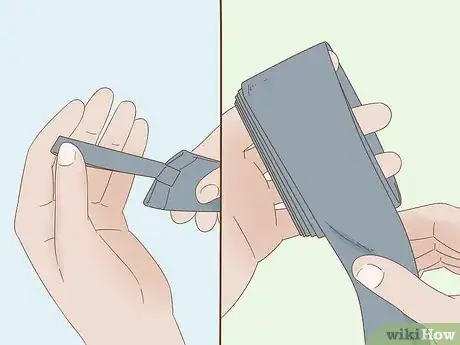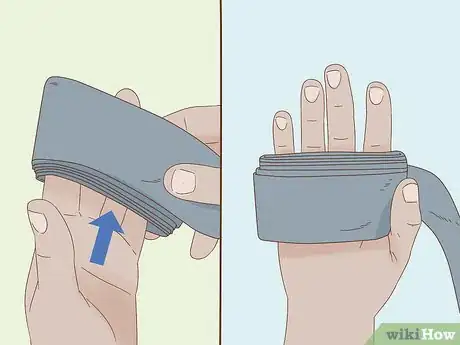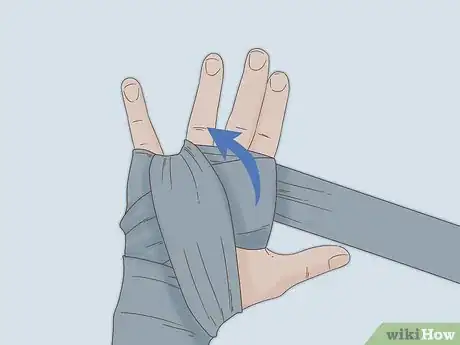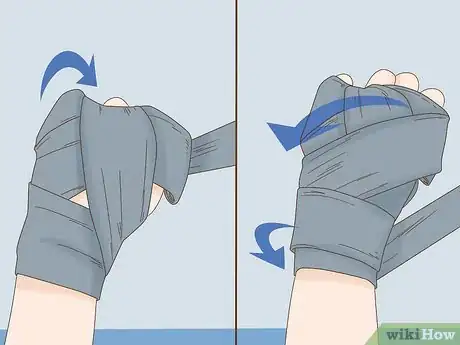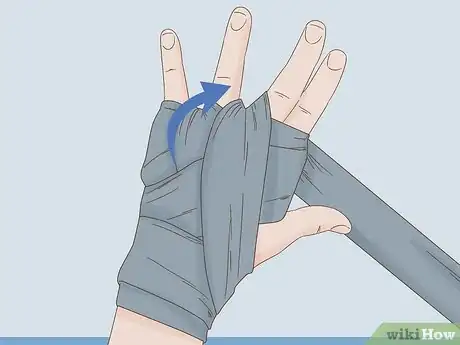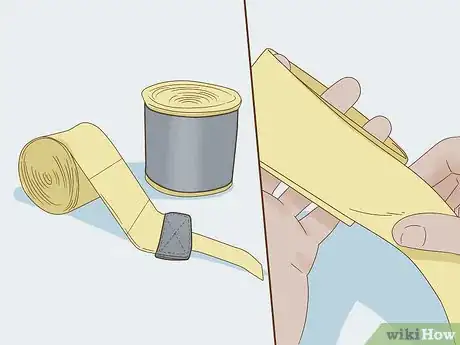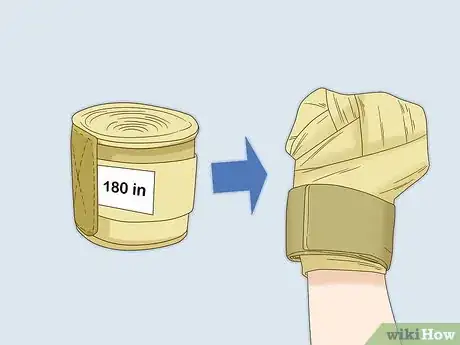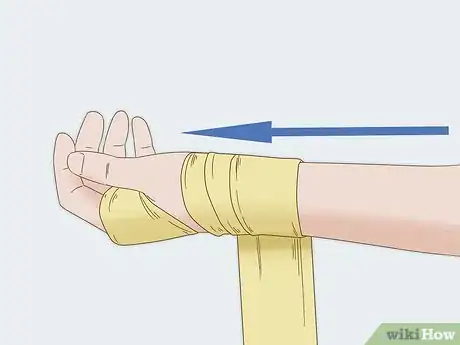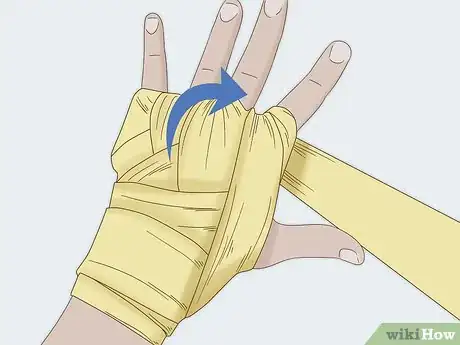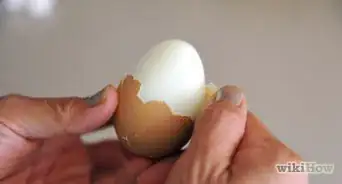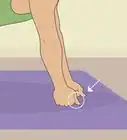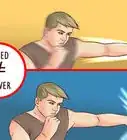This article was co-authored by David Engel. David Engel is a Muay Thai Instructor and Self Defense Trainer based in the San Francisco Bay Area. With over 15 years of martial arts instruction and training experience, David runs California Martial Athletics with co-owner Joe Chernay. He has created and maintained martial arts programs at Rise Combat Sports in San Francisco and Round 5 Martial Arts Academy in San Leandro, with a mission to provide students with a level of comfort and competency that manifests both within and outside the martial arts context. He is also a registered cornerman for amateur and pro competitors under the IKF (International Kickboxing Federation). David was the youngest apprentice instructor of the Thai Boxing Association of America under Ajarn Chai Sirisute (2009), and was a top-ranked amateur competitor in his weight class (127-130 lb) in California between 2013 and 2015.
There are 10 references cited in this article, which can be found at the bottom of the page.
This article has been viewed 38,659 times.
Before you train or fight in Muay Thai, you need to wrap up both of your hands to protect them from damage. Most practitioners use a pair of elastic bands with Velcro to protect their muscles and bones from damage. In Muay Thai, you make a basic wrap by folding the band into a pad, then winding the remaining material around your wrist and between your fingers. A comfortable wrap allows you to fight with not only greater safety, but increased precision and strength as well.
Steps
Winding the Wrap
-
1Hold the thumb loop against your palm and wrap your fingers 6 times. Position the thumb loop so its end is aligned with the edge of your index finger above the knuckle. Spread your fingers out slightly as you begin wrapping them. Squeezing them together will cause the wrap to be too tight and restrictive.[1]
- Many Muay Thai fighters roll their wraps inside-out. To do this, unroll your wrap, then roll it back up tightly with the adhesive patch facing inward. This will make wrapping your hands a little easier.[2]
- It doesn’t really matter if you start by taking the wrap around the back of your hand or underneath it. As long as you wrap up your wrist and each finger, your hands will be secure.
-
2Slip the wrap off your hand and secure it to your knuckles. Pull the wrap off carefully, holding the layers together so the wrap doesn’t fall apart. Set the pad on the back of your hand and pinch it in place with the side of your thumb. Pick up the roll of the remaining fabric with your other hand, which will be by either your pinky or thumb. Wrap it underneath your hand, between your thumb and index finger, and over the pad to secure it in place.[3]
- Bring the wrap around your hand 3 times to secure the pad to your knuckles.[4]
- Avoid wrapping your thumb at this point. For now, you need it free so you have more freedom of movement.
- Make sure the wrap feels snug against your hand at all times. If it feels too loose or too tight, unroll it and start again.
Advertisement -
3Cross the wrap down and around your wrist 3 times. Move your thumb to the side to get it out of the way. Bring the wrap diagonally down between your thumb and index finger to the edge of your wrist on the opposite side of your hand. Finish protecting your wrist by wrapping it up snugly.[5]
- Hold your wrist straight as you wrap it. Wrapping your wrist while it is crooked increases your chances of injuring it.
-
4Bring the wrap up between your ring and pinky finger. Stop when you have the roll of wrap next to your thumb. From this position, take the wrap diagonally upward, across the back of your hand, to your pinky. After moving the roll between your fingers, hold the wrap near your palm for a moment.[6]
- To achieve proper wrapping technique, you will need to flex your fingers. Keep your fingers straight until you have brought the wrap between them.
-
5Close your hand into a fist, then wind the wrap down around your wrist. Bring the wrap around your palm to your thumb. Pass the wrap between your thumb and index finger again. Wrap diagonally downwards towards the edge of your wrist, then complete a full loop around it. The wrap roll will be back at your thumb when you’re done.[7]
- Flex your fingers to test the wrap. Make sure it feels secure but not restrictive.
-
6Secure your remaining fingers by passing the wrap between them. You will need to repeat the previous motions a total of 3 times. Start by bringing the fabric between your middle and ring fingers. Wrap diagonally towards to your wrist, then go all the way around your wrist so the wrap ends up near your thumb. Then, do this for the remaining sets of fingers.[8]
- Remember to close your hand into a fist every time you pass the wrap between 2 fingers. Make sure the wrap is at the proper consistency before continuing.
-
7Bring the wrap around your wrist and secure it in place. If you haven’t already, take the wrap around your thumb and down to the edge of your wrist below it. You won’t have much wrap left, only enough to pass around your wrist 2 or 3 more times. Press the adhesive end against your wrist to hold the wrap in place, then give it a good test before getting into the ring.[9]
- The wrap should stop about 3/4 of the way up your forearm.[10]
- To test the wrap, close your hand into a fist. Check that your knuckles are level with your fingers. Make sure your wrist looks straight in the wrap so it doesn’t bend while punching.
- This is the traditional wrapping style used by many experienced Muay Thai fighters. Some fighters prefer a boxing-style wrap, which may be a little bulkier but still effective.
Using the Right Wrap and Technique
-
1Select an elastic wrap that fits comfortably on your hands. Basic hand wraps are made with cotton and held in place with a patch of Velcro. The most useful type of wrap you can get are elastic wraps, also called Mexican hand wraps. The elastic fibers make these wraps easier to put on and more comfortable to wear.[11]
- Non-elastic wraps are also an option. These wraps tend to be more durable than elastic wraps, so they’re particularly good for training sessions.
- The most important part is comfort. Pick a wrap you are most comfortable using and get spares so you always have a clean pair available.
-
2Choose a wrap that is long enough to fit over your hand. A standard wrap is about 180 in (460 cm) long. This is an ideal size for most adults. However, wraps are available in all sorts of sizes, including junior sizes. You can only learn what size is right for you by trying on wraps of different lengths.[12]
- Choosing a wrap length is a personal process. The length you need depends on how you wrap your hands and what feels best to you.
- If you can’t finish wrapping your hands by bringing the fabric around your wrist a few times, you need a longer wrap. Similarly, if you have a lot of material left when you’re done wrapping, try a shorter wrap.
-
3Hold your wrist straight while wrapping your hand. Bending your wrist makes it more prone to injury. Your wrist needs to be level with your hand and forearm at all times. If you bend your wrist at all, the wrap will hold it in a bent position. Undo the wrapping and start over to avoid any problems.[13]
- Make sure your wrist feels comfortable in the wrapping. If it feels bent, hitting something can cause it to bend further. Never begin sparring unless you are sure your hands are well-wrapped.
-
4Pad your fingers around the first knuckle. When your hands are well-wrapped, your fingers are cushioned but still free to move independently. This is done in Muay Thai by taking the wrap between your fingers and around your wrist. Avoid wrapping your hands beyond the first knuckle, since the wrap will restrict your fingers.[14]
- For protection, make sure the wrap is thick around each knuckle as well as your wrist.
- When you wrap your hands correctly, the wrap will feel snug enough to stay in place, but it won’t feel tight enough to hinder your circulation.
Expert Q&A
-
QuestionHow do I properly wrap my hands for Muay Thai?
 David EngelDavid Engel is a Muay Thai Instructor and Self Defense Trainer based in the San Francisco Bay Area. With over 15 years of martial arts instruction and training experience, David runs California Martial Athletics with co-owner Joe Chernay. He has created and maintained martial arts programs at Rise Combat Sports in San Francisco and Round 5 Martial Arts Academy in San Leandro, with a mission to provide students with a level of comfort and competency that manifests both within and outside the martial arts context. He is also a registered cornerman for amateur and pro competitors under the IKF (International Kickboxing Federation). David was the youngest apprentice instructor of the Thai Boxing Association of America under Ajarn Chai Sirisute (2009), and was a top-ranked amateur competitor in his weight class (127-130 lb) in California between 2013 and 2015.
David EngelDavid Engel is a Muay Thai Instructor and Self Defense Trainer based in the San Francisco Bay Area. With over 15 years of martial arts instruction and training experience, David runs California Martial Athletics with co-owner Joe Chernay. He has created and maintained martial arts programs at Rise Combat Sports in San Francisco and Round 5 Martial Arts Academy in San Leandro, with a mission to provide students with a level of comfort and competency that manifests both within and outside the martial arts context. He is also a registered cornerman for amateur and pro competitors under the IKF (International Kickboxing Federation). David was the youngest apprentice instructor of the Thai Boxing Association of America under Ajarn Chai Sirisute (2009), and was a top-ranked amateur competitor in his weight class (127-130 lb) in California between 2013 and 2015.
Muay Thai Instructor & Self Defense Trainer Take the hand wrap and use a back-and-forth motion to fold it 8-10 times, so it's about the size of your fist. Place that bed of padding on top of your knuckles, with the tail end of the wrap away from your pinky finger. Then, wrap 3 times on top of that bed of padding to secure it to your knuckles. After the 3rd time, bring the wrap from your wrist in between your pinky and ring fingers. Go in between the index finger and thumb again, wrap behind your hand to your wrist again, then go in between the ring and middle finger. Then, go back to the palm, between the index and thumb, and between the middle and index fingers. Go back around your thumb and index finger one more time, wrap two times around the palm of your hand, and finish by wrapping your wrist.
Take the hand wrap and use a back-and-forth motion to fold it 8-10 times, so it's about the size of your fist. Place that bed of padding on top of your knuckles, with the tail end of the wrap away from your pinky finger. Then, wrap 3 times on top of that bed of padding to secure it to your knuckles. After the 3rd time, bring the wrap from your wrist in between your pinky and ring fingers. Go in between the index finger and thumb again, wrap behind your hand to your wrist again, then go in between the ring and middle finger. Then, go back to the palm, between the index and thumb, and between the middle and index fingers. Go back around your thumb and index finger one more time, wrap two times around the palm of your hand, and finish by wrapping your wrist.
References
- ↑ https://www.youtube.com/watch?v=zLMnE9SUVNg&feature=youtu.be&t=11
- ↑ https://www.youtube.com/watch?v=KYrybP5FZqQ&feature=youtu.be&t=22
- ↑ https://www.youtube.com/watch?v=d3O5Te8LrNA&feature=youtu.be&t=91
- ↑ David Engel. Muay Thai Instructor & Self Defense Trainer. Expert Interview. 5 May 2020.
- ↑ https://www.youtube.com/watch?v=stH8V29yCFQ&feature=youtu.be&t=101
- ↑ David Engel. Muay Thai Instructor & Self Defense Trainer. Expert Interview. 5 May 2020.
- ↑ https://www.youtube.com/watch?v=Nf6Qb3EWr-0&feature=youtu.be&t=198
- ↑ David Engel. Muay Thai Instructor & Self Defense Trainer. Expert Interview. 5 May 2020.
- ↑ https://www.youtube.com/watch?v=KYrybP5FZqQ&feature=youtu.be&t=247
- ↑ David Engel. Muay Thai Instructor & Self Defense Trainer. Expert Interview. 5 May 2020.
- ↑ https://youtu.be/KYrybP5FZqQ?t=10
- ↑ https://youtu.be/KYrybP5FZqQ?t=10
- ↑ https://www.youtube.com/watch?v=zLMnE9SUVNg&feature=youtu.be&t=71
- ↑ https://www.youtube.com/watch?v=stH8V29yCFQ&feature=youtu.be&t=210
